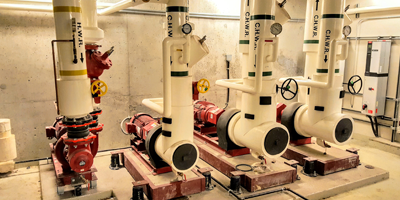Closed Loop
Efficiency Begins From Within
The Closed Loop Treatment Program uses field-proven products and services that protect components from corrosion, improve system performance, save on energy consumption, and reduce GHG emissions.
What is a Closed Loop System?
Closed Loop heating and chilled water systems circulate water through a piping system intended to heat and cool a building. “Closed Loop” implies the recirculation of the same water, typically requiring little to no makeup water following the initial system charge.
However, even small unexpected water leaks can introduce corrosive elements, such as oxygen, that degrade these systems.

Related Article
A Guide To Energy Saving Hydronic Additives
Energy saving additives for hydronic systems are the simplest way to instantly reduce building energy consumption and emissions by up to 15%.
Problems in Closed Loop Systems
Corrosion, scale, fouling and microbiological growth are considered the four major problems in all types of circulating water systems. In Closed Loop systems, corrosion stands out due to the introduction of dissolved oxygen from the raw water makeup.
Dissolved oxygen causes mild steel and iron to corrode rapidly, releasing small flakes of rust into the recirculating stream. Abrasive particles erode pump seals, cause leakage, reduce heat transfer efficiency and block pipes. The result is expensive equipment replacement and excessive downtime.
Closed Loop System Solutions
The Closed Loop Treatment Program is designed to economically improve operations while decreasing the carbon footprint. We identify and eliminate the source(s) of significant water loss, protect system components from corrosion, improve heat transfer efficiency, save on energy consumption, and cut GHG emissions.
The program includes our on-site testing services, e-Service Reporting, and implementing a film-forming corrosion inhibition treatment that provides excellent corrosion rate protection as recommended by the Association of Water Technologies (AWT).
- Mild steel corrosion rates <0.50 mpy
- Copper corrosion rates <0.10 mpy
The Closed Loop Treatment Program works in tandem with our energy saving program, EndoTherm®, to reduce the surface tension of the system water, increase heat transfer, optimize energy gains and lower fuel cost/usage.
Application






Resources
FAQ
If leaks are suspected, installation of an inexpensive totalizing water meter in the make-up line will provide early detection. Regular testing of the water can also detect leaks.
The fluid in a closed system usually contains a suspension of fine, abrasive particles which are harmful to equipment (i.e. pump seals), and leads to unscheduled shutdowns and increased maintenance. There are various sources of these particles, mostly resulting from corrosion. Side stream filtration and scheduled filter changes are necessary to minimize the risk of damage.
Yes. Boilers manufactured with aluminum or stainless steel heat exchangers are extremely sensitive to the high pH levels used in traditional closed loop treatments. Typical closed loop treatments inhibit corrosion using pH buffering, and it is not uncommon to operate at values from pH 9.0 to 10.5. Aluminum starts to degrade rapidly at pH values above 8.5 and stainless steel at pH values above 9.0. Consult with your Pace Technical Representative for the specific corrosion inhibitor treatment recommended for your heating systems with aluminum or stainless steel metallurgy.
Closed loop water should be almost clear and colourless. Dark brown or black water indicates a serious corrosion problem. There should be very few solid particles collecting at the bottom of the sample container. Consult with a Pace Technical Representative in your area for further analysis to determine the water quality.
Quick Contact
Fill out this form and we'll get back to you very shortly.
For more ways to get in touch with Pace locally, visit our Contact Us page.





